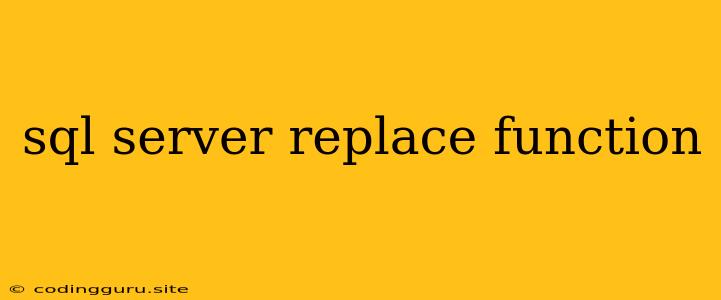The Power of Replacing Strings: A Deep Dive into SQL Server's REPLACE Function
In the realm of SQL Server, data manipulation is a core operation, and within that landscape, the ability to modify strings is paramount. The REPLACE function stands as a versatile tool for achieving precisely this - replacing specific occurrences of substrings within a given string.
This article will delve into the heart of the REPLACE function, exploring its capabilities and practical applications within the context of SQL Server. We will examine its syntax, diverse use cases, and how it can be leveraged to enhance data processing and manipulation tasks.
The Fundamentals of REPLACE: Syntax and Usage
At its essence, the REPLACE function takes three arguments:
- Original String: The string you wish to modify.
- Search String: The substring you want to replace.
- Replacement String: The substring that will replace the occurrences of the search string.
The syntax is straightforward:
REPLACE (original_string, search_string, replacement_string)
Let's illustrate with an example:
SELECT REPLACE('Hello World!', 'World', 'Universe');
This query will output:
Hello Universe!
In this instance, the REPLACE function successfully swapped the word "World" with "Universe".
Beyond Simple Substitution: Advanced Scenarios
The REPLACE function possesses the power to handle a wide array of string manipulation tasks, including:
- Case-Insensitive Replacement: By using the
LOWERfunction, you can perform replacements without concern for case sensitivity. For example, to replace both "hello" and "Hello" with "Greetings", you would use:
SELECT REPLACE(LOWER('Hello World!'), 'hello', 'Greetings');
- Multiple Occurrences: The
REPLACEfunction diligently replaces all instances of the search string within the original string. This can be immensely useful when standardizing data or removing specific characters.
SELECT REPLACE('This string has multiple commas, , , ,', ',', ' ');
This query will result in:
This string has multiple commas
- Replacing Special Characters: The
REPLACEfunction can be employed to sanitize data by replacing undesirable characters, such as those that could cause errors during data ingestion or processing.
SELECT REPLACE('Product#123', '#', '');
This query will yield:
Product123
Practical Applications in the Real World
The versatility of the REPLACE function makes it a valuable tool for:
- Data Cleansing: Removing unwanted characters, such as spaces, tabs, or newlines, can significantly improve data quality and consistency.
SELECT REPLACE(LTRIM(RTRIM(' Unclean Data ')), ' ', '') AS CleanedData;
- Standardizing Data: Ensure data uniformity across multiple sources by standardizing formats, such as converting date formats or replacing inconsistent spellings.
SELECT REPLACE(CustomerName, 'St.', 'Street');
- Data Validation: The
REPLACEfunction can be used to identify potential errors in data, such as duplicate entries or incorrect values.
SELECT CASE WHEN REPLACE(PhoneNumber, '-', '') = PhoneNumber THEN 'Valid' ELSE 'Invalid' END AS PhoneNumberStatus;
- Data Masking: Protect sensitive data by replacing it with generic values, enhancing data security.
SELECT REPLACE(SSN, '123', 'XXX');
Conclusion: Empowering String Manipulation in SQL Server
The REPLACE function is a fundamental building block for string manipulation in SQL Server. Its ability to replace specific occurrences of substrings within a string unlocks a wide range of possibilities for data transformation, cleansing, standardization, and more. By understanding its syntax, usage, and diverse applications, you can effectively leverage this function to elevate your data manipulation capabilities within SQL Server.
